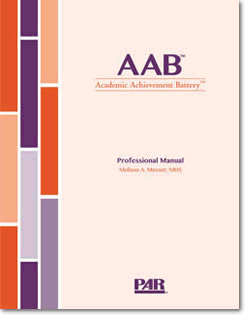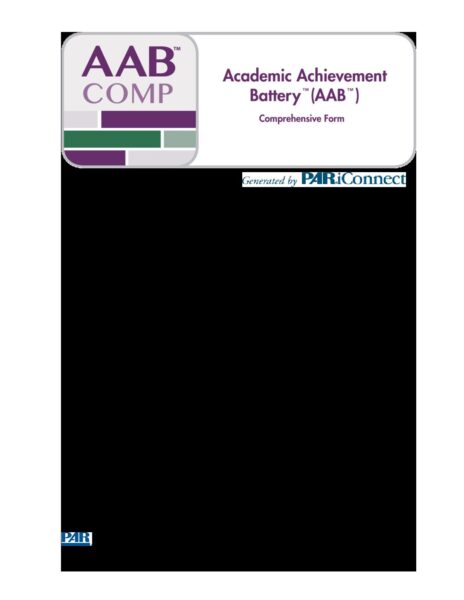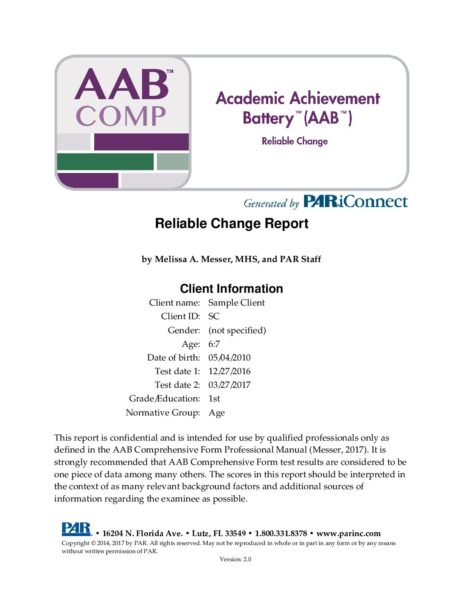
Academic Achievement Battery™ [AAB]
Assess basic academic skills of reading, spelling, and math with the Standard Form; four areas of achievement including a measure of writing with the Screening Form; or seven areas of achievement throughout the life span with the Comprehensive Form
For Ages: 4 – 85 years
Administration Time: Standard and Screening Forms 15-30 minutes, Comprehensive Form 90 minutes
Format: Paper and pencil, Online scoring via PARiConnect, E-Manual
Author: Melissa A. Messer
Books & Workbooks
Click to browse products
Printed Manuals
Physical printed manuals.
Printed Forms & Handscoring Materials
Test forms, response booklets and scoring reference manuals.
Online Forms, Reports, Kits & e-Manuals
All online resources including Forms, Reports, i-Admins, Kits and e-Manuals.
AAB Laminated Stimulus Card
AAB Professional Manual includes Fast Guide
AAB Item Booklets (pkg/25)
AAB Response Booklets (pkg/25)
AAB Comprehensive Form online Score Reports (each) min order 5
AAB Screening Form online Score Report (each) min order 5
AAB Standard Form online Score Reports (each) min order 5
AAB e-Manual (includes Fast Guide e-Manual)
The AAB family of products has expanded to fulfil all your academic testing needs! The AAB measures basic reading, math, spelling, and reading comprehension quickly and thoroughly to get an accurate overview of an individual’s academic skills.
The AAB is ideal for evaluating fundamental academic skills during an initial evaluation, during re-evaluation, or when working with those referred for learning, behaviour, or vocational concerns. The AAB is a complete achievement assessment, offering both a comprehensive battery and a screening version for use with individuals throughout the life span.
Features and benefits
- Measures basic academic skills, including basic reading, spelling, mathematical calculation, and reading comprehension.
- All four subtests are included in one easy-to-use response booklet. Administration and scoring are straightforward and easy; both comprehensive and screening versions have a Fast Guide to help you get started.
- Developed using academic standards set by the National Council of Teachers of Mathematics, the National Council of Teachers of English, Common Core, and Reading First.
- Reading subtests combine to provide a Reading Composite, which provides more data to understand an individual’s reading skills.
- A Total Composite Score provides the user with a snapshot of an individual’s academic performance.
- Unlike similar measures, the AAB requires no certification or intensive preparation—simply open your AAB kit and review the materials, and you will be ready to begin assessment.
- Provides age- and grade-based (fall and spring) norms.
- Scoring is available through PARiConnect; stimuli are available digitally.

Standard Form
- Assess achievement throughout the life span
- Reliability coefficients for the subtests range from .77 to .97 and from .88 to .98 for the composite scores across the age- and grade-based normative samples.
- AAB subtest and composite scores were found to be highly correlated with similar constructs on the WJ® III, KTEA™-II, WRAT4, and WIAT®-III.
- Discrepancy data with the RIAS-2 offer users the ability to compare AAB scores with an IQ assessment. When used together, the RIAS-2 and AAB offer a valid and efficient way to thoroughly assess intelligence and academic achievement.
- The manual includes evidence supporting the ability of the AAB to differentiate performance in individuals with various learning disabilities, intellectual developmental disorder, ADHD, and speech/language impairment.
- Recent normative data give you confidence in your results.
Comprehensive Form
- Assess seven areas of achievement throughout the life span
- Can be administered in about 90 minutes and scored in 15 minutes.
- The Academic Achievement Battery Composite, a total score, provides an overview of the individual’s overall performance on the various aspects of achievement measured by the AAB.
- A skills analysis enables you to investigate the individual’s strengths and weaknesses and offers a wealth of data with which to make interpretations and recommendations.
- Provides composite-to-composite and subtest-to-subtest discrepancy scores and reliable change scores.
- Reliability coefficients for the subtests range from .77 to .97 and from .88 to .98 for the composite scores across the age- and grade-based normative samples.
- AAB subtest and composite scores were found to be highly correlated with similar constructs on the WJ® III, KTEA™ -II, WRAT4, and WIAT® -III.
- The manual includes evidence supporting the ability of the AAB to differentiate performance in individuals with various learning disabilities, intellectual disorder, ADHD, and speech/language impairment.
- Includes reliable change scores and ability–achievement discrepancies with the Reynolds Intellectual Assessment Scales™, Second Edition (RIAS™2). A combination kit is also available!
Screening Form
- Assess four areas of achievement throughout the life span
- Can be administered in 15-30 minutes and scored in 5-10 minutes.
- All four subtests are included in one easy-to-use response form.
- Measures basic academic skills, including letter and word reading, spelling, and mathematical calculation.
- An optional written composition component requires an extra 15 minutes to administer.
- A composite score provides the user with a snapshot of the individual’s performance in reading, spelling, writing, and math.
- Appropriate for evaluating fundamental academic skills during an initial evaluation, during re-evaluation, or when working with those referred for learning, behaviour, or vocational concerns.
- Reliability coefficients for the subtests range from .77 to .97 and from .88 to .98 for the composite scores across the age- and grade-based normative samples.
- AAB subtest and composite scores were found to be highly correlated with similar constructs on the WJ® III, KTEA™ -II, WRAT4, and WIAT® -III.
- The manual includes evidence supporting the ability of the AAB to differentiate performance in individuals with various learning disabilities, intellectual developmental disorder, ADHD, and speech/language impairment.





